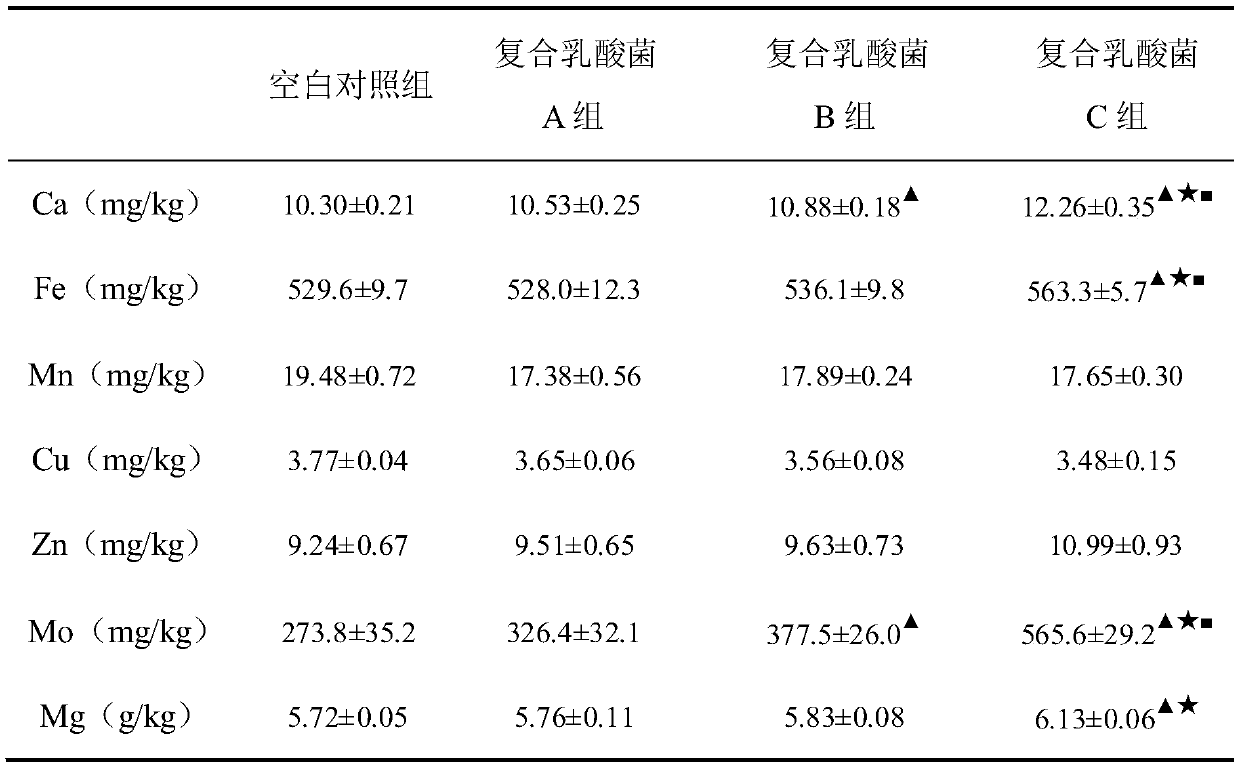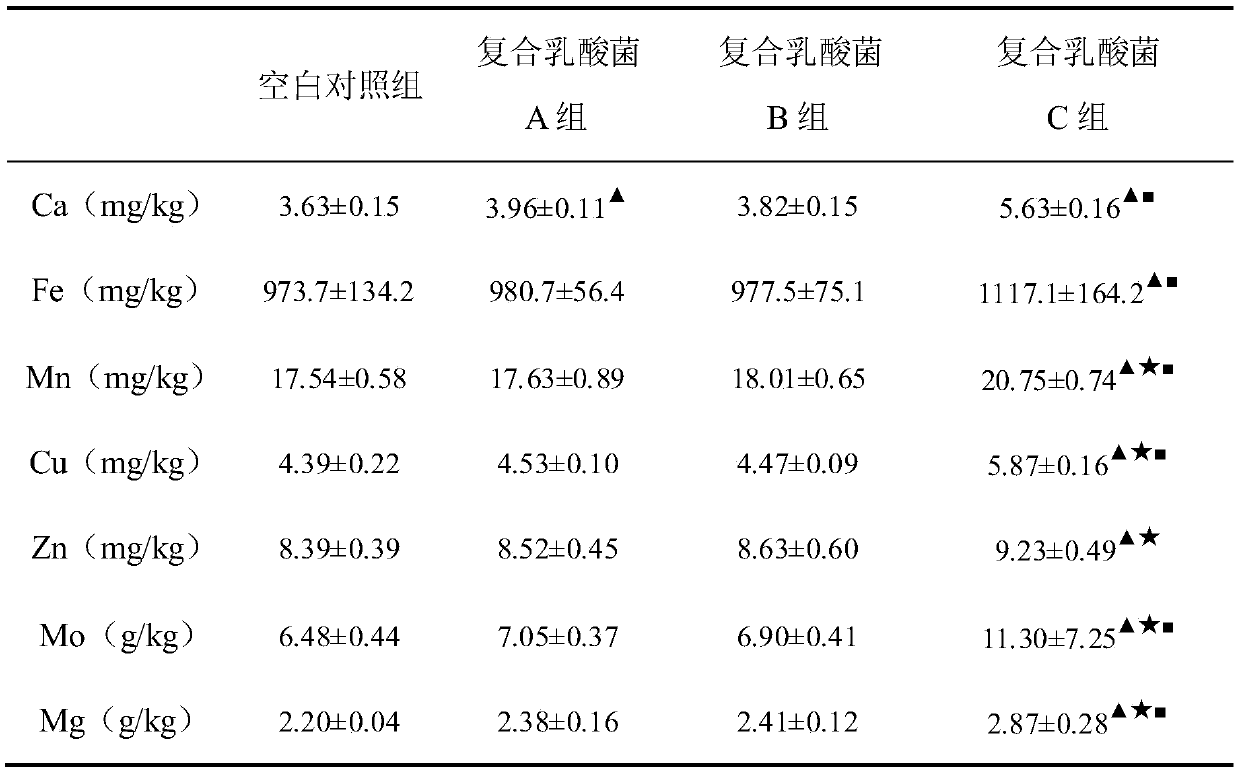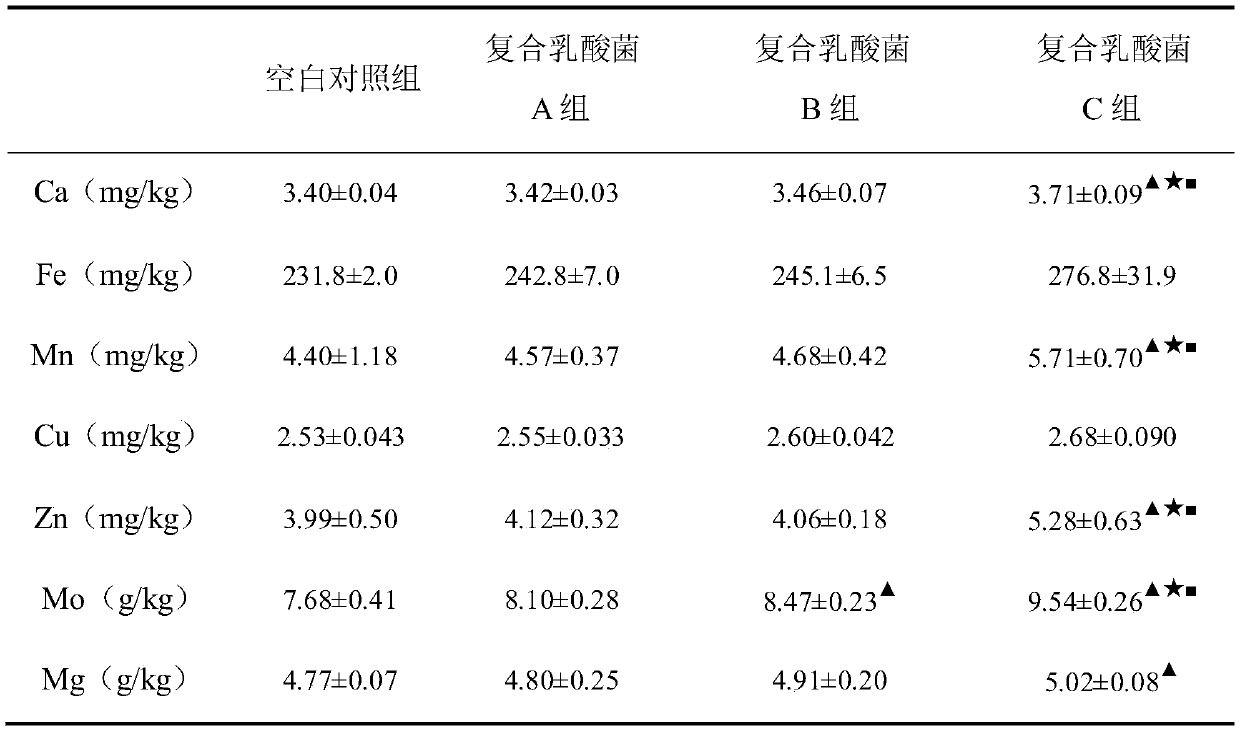A compound lactic acid bacteria preparation and its application for improving the utilization rate of peanut micronutrients in saline-alkali land
A technology of compounding lactic acid bacteria and saline-alkali soil, applied in the field of microorganisms, can solve the problems of easy lack of trace elements, aggravating the obstacles of continuous peanut cropping, affecting the yield of peanuts, etc.
- Summary
- Abstract
- Description
- Claims
- Application Information
AI Technical Summary
Problems solved by technology
Method used
Image
Examples
Embodiment 1
[0019] Embodiment 1: the preparation of compound lactic acid bacteria agent
[0020] (1) Inoculate Lactobacillus plantarum P-8, Lactobacillus casei Zhang, and Lactobacillus plantarum CCFM8661 in the MRS culture medium at 6% inoculum, and inoculate at 35-37°C Cultivate at a constant temperature for 18 hours, after centrifugation and washing, add 10% sterilized skim milk emulsion, 0.6% glucose and 0.8% yeast extract to the bacterial precipitate, and adjust the number of bacteria to be greater than 2.0×10 9 cfu / mL, mix well and pour into culture respectively.
[0021] (2) The protective agent was prepared using sterile water, which consisted of: 100g / L skimmed milk powder, 30mL / L glycerin, 100g / L maltodextrin, 150g / L sea lacquer sugar and 10g / L-sodium glutamate.
[0022](3) The cultures of Lactobacillus plantarum (Lactobacillus plantarum) P-8, Lactobacillus casei (Lactobacillus casei) Zhang and Lactobacillus plantarum (Lactobacillus plantarum) CCFM8661 strain culture obtained in...
Embodiment 2
[0024] Embodiment 2: the preparation of compound lactic acid bacteria agent
[0025] (1) Inoculate Lactobacillus plantarum (Lactobacillus plantarum) P-8 and Lactobacillus casei (Lactobacillus casei) Zhang in the MRS culture medium at an inoculum size of 6%, culture at a constant temperature of 35-37°C for 18 hours, and wash by centrifugation Finally, add 10% sterilized skim milk emulsion, 0.6% glucose and 0.8% yeast extract on the thalline precipitation, and adjust its bacterial count to be greater than 2.0×10 9 cfu / mL, mix well and pour into culture respectively.
[0026] (2) Use sterile water to prepare a protective agent, consisting of: 100g / L skimmed milk powder, 30mL / L glycerin, 100g / L maltodextrin, 150g / L sea lacquer sugar and 10g / L L-sodium glutamate.
[0027] (3) Inoculate the cultures of Lactobacillus plantarum P-8 and Lactobacillus casei Zhang obtained in step (1) into the MRS culture medium respectively, and cultivate them at a constant temperature of 35-37°C for 1...
Embodiment 3
[0029] Embodiment 3: the preparation of compound lactic acid bacteria agent
[0030] (1) Inoculate Lactobacillus plantarum (Lactobacillus plantarum) CCFM8661 and Lactobacillus casei (Lactobacillus casei) Zhang in the MRS culture medium at a 6% inoculum amount, culture at a constant temperature of 35-37°C for 18 hours, and centrifuge and wash , add 10% sterilized skim milk emulsion, 0.6% glucose and 0.8% yeast extract on the thallus precipitation, and adjust the number of bacteria to be greater than 2.0×10 9 cfu / mL, mix well and pour into culture respectively.
[0031] (2) Use sterile water to prepare a protective agent, consisting of: 100g / L skimmed milk powder, 30mL / L glycerin, 100g / L maltodextrin, 150g / L sea lacquer sugar and 10g / L L-sodium glutamate.
[0032] (3) Inoculate the cultures of Lactobacillus plantarum CCFM8661 and Lactobacillus casei (Lactobacillus casei) Zhang strains obtained in step (1) into the MRS culture medium respectively, and culture them at a constant ...
PUM
 Login to View More
Login to View More Abstract
Description
Claims
Application Information
 Login to View More
Login to View More - R&D Engineer
- R&D Manager
- IP Professional
- Industry Leading Data Capabilities
- Powerful AI technology
- Patent DNA Extraction
Browse by: Latest US Patents, China's latest patents, Technical Efficacy Thesaurus, Application Domain, Technology Topic, Popular Technical Reports.
© 2024 PatSnap. All rights reserved.Legal|Privacy policy|Modern Slavery Act Transparency Statement|Sitemap|About US| Contact US: help@patsnap.com










